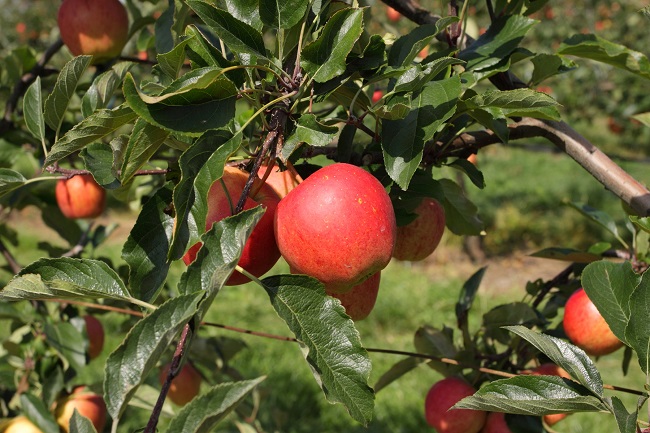Do you have a fruit tree or trees in your yard that just don’t seem to know how to make fruit? Are you frustrated with your fruit trees and their lack of adequate fruit production? I know it can be frustrating, but fruit trees are programmed at birth to be robotic fruit producing machines. It’s all they know how to do. Make leaves, put on new growth each season, make flowers and later in the season make fruit. Rinse and repeat. It’s really the only thing they know how to do.

If your fruit trees seem to have dropped their built-in program and just can’t get fruit production right, chances are, there are some environmental conditions at play that you can adjust and get your fruit trees back on track.
The Age of the Tree Makes a Difference in Fruit Production
Young trees need from two to five years before they really start blooming profusely which is what you need for good fruit production. Apple and apricot trees need at least two years, sour cherry, and peach at least three years, pear at least four years and sweet cherry and quince can take up to five years before they really start producing fruit. So, age of the tree does mean something.
Soil Conditions
Soil conditions are extremely important, probably more important that anything else in the equation because healthy happy trees make more fruit. Poor soil conditions make for a tree that is struggling and stressed. Insect and diseases are more likely to attack a weak tree or a tree that is under a great deal of stress.
Happy Trees Make Lots of Fruit
A tree that is growing along mightily and appears to be perfectly happy with its environment is going to fight off insects and diseases better than an unhappy tree. A happy tree means a more vibrant tree, a tree free of insect and disease issues, therefore bountiful fruit production. When you think about it, it’s a simple equation.
However, this is where and how it all goes wrong. Be careful about how, when, or why you amend the soil when you plant new fruit trees. You need to understand what kind of soil you have and what, if any amending it needs. If it ain’t broke, don’t fix it. Sometimes we gardeners do harm when we are really trying to do the right thing. If you have pretty good soil in your yard just plant your tree and back fill around it with the soil you have. If your soil is dark brown and not sticky like mud your fruit trees should be perfectly happy in it.
How to Amend Soil with Sand and Gravel
Sand and gravel that doesn’t appear to have much at all in the way of nutritional value might not be as bad as you think. I learned this back when I was building my original backyard nursery. My yard was pure sand and gravel with very little topsoil. I dug out some areas in the yard to build cold frames and a greenhouse pit etc and had four large piles of soil piled up in my backyard from this excavation effort. Most of the soil in those piles was nothing but lots and lots of gravel. One pile for sure seemed troubling to me because I dug down about 24″ for my sunken greenhouse so that pile of soil contained almost zero soil, or so it seemed.
None the less, I had to do something with those piles of soil and hauling them away was not an option so I created gardens. Most of the soil was gravel, a little sand, but mostly gravel with little or no organic matter. When I planted trees and shrubs, I simply dug holes and dropped in the plants. I didn’t add peat moss, or compost, or fertilizer. I just dug a hole and dropped in the plants. They not only did amazingly well, but they also thrived. I mean they thrived, and I learned something.
If you have sand and gravel in your yard this is what I recommend in the way of soil amendments. When you back fill the hole mix in some bagged or well rotted cow manure or well rotted compost. It won’t do any harm and it is sure to help. Do you have to? No, but the plants will appreciate it.
How to Amend Clay Soil
Clay soil is challenging, so much so that I would be an extremely unhappy person if I had a yard full of really poor clay soil. Fruit trees (really all plants) do not like clay soil because it suffocates the roots, and they cannot breathe. Plant roots must have the ability to transfer oxygen through the soil to the root systems. If that can’t happen the plants suffer or flat out die. So, when you set out to amend your clay soil for the planting of fruit trees, you really must think this through before you start. You must be aware of the bathtub effect.
If you dig a hole in clay soil, stick in a tree, bare root or balled, it doesn’t make a difference, then back fill around that tree with things like peat moss, compost, and good topsoil, you probably think you have done a wonderful thing for your new tree. The materials that you used to back fill the hole are nice and loose and porous and the plant will be able to breath nicely. Not so fast! What you have really done is you have created a way for water to get into the hole that you dug, but there’s no way for the water to get out. Your tree is going to drown. Literally drown, because once the hole fills up with water the tree can’t breathe.
How to Plant in Clay Soil
When planting in clay soil what you need to do is only dig part of a hole and only put part of the tree ball in the ground. I say no more than half of the ball should be in the ground, but I really like only 25% of the tree ball in the ground even better. Then cover the part of the ball that is exposed above ground with an ample amount nice soil that is high in organic matter. This is exactly how you do it, dig your shallow hole then drop the ball into the hole. At least half of the ball should be above grade. Before you do anything else, back fill around the ball with the same soil that you removed from the hole. That’s right; back fill around the tree ball with the clay soil, but only enough to fill in around the ball. Dispose of the clay soil that you don’t need. This will keep the hole from filling up with water. You are sealing around the ball of the tree with the clay soil to keep excess water out.
Now start filling around the exposed part of the ball with good, rich topsoil. But you really need to make this “raised area” much wider that the ball itself because with the ball being raised out of the ground like it will dry out more easily plus you need a place for the tree to grow new roots. If your tree ball is 12″ in diameter I suggest that you create a raised bed that is 36″ in diameter. Sure, this is a lot of work and a lot more effort, but you are doing a good thing for your fruit tree. Consider it a long-term investment.
When somebody has a plant that is not doing well, not making enough fruit, or making poor fruit, they frequently conclude that their plant must be suffering from xyz disease or is being secretly eaten alive by xyz bug, when in fact, the only thing wrong with the tree is that it is not happy with where it’s planted or how it was planted.
3 Things to Look For
There are three things that typically make plants unhappy. The first is being planted too deep. Even in good soil the top of the plant root ball should be about one inch above grade and then be covered with about an inch of soil and then two to three inches of mulch. This allows the roots of the plant to breathe which is really important.
The second is that they are planted in poor soil and the top of the root ball is covered with poor soil. The plant simply cannot breathe and the tree or the plant is literally suffocating.
The third reason is that they are too wet. This happens for a lot of different reasons. The tree is planted in clay soil; the hole is too deep or too wide and filled with porous material allowing water to get in but not get out. Putting gravel in the bottom of the hole does absolutely no good. All that does is makes more room for stagnant water to stand and no way for the water to get out. You cannot plant a tree in a wet area and expect it to “dry up the area”. The only thing that will happen is that the tree will die. Over watering the plant will kill trees and plants too. People tend to think newly planted plants need lots of water and just keep turning the hose on the plant. Before you water, stick your hand down into the soil and feel the soil. It should be cool and moist, not wet, and soggy. You can buy a moisture meter for just a few dollars.
Poor Pollination Can be a Problem
Fruit trees make flowers, and the flowers have to be pollinated before the bloom can turn into fruit. Some fruit trees are self-pollinators, but most are not. For instance, with apple trees, you have to plant at least two, if not more, different, varieties in fairly close proximity to each other so they can cross pollinate. This is true for just about all fruit trees. It’s a bit of a dating ritual; they need to get out and meet new people. Then they’ll make fruit. Since trees are stationary and can’t get around to meet new people, they order in! They depend on bees and other insects to pick up pollen from one tree and deliver it to other trees.
Take Care of the Bees
Be careful to not over care for your fruit trees by spraying with all kinds of insecticides and such. If you spray when the trees are in bloom you are certain to kill off many of your pollinators in the process.
Mike McGroarty is the owner of McGroarty Enterprises and the author of several books. You can visit his website at Freeplants.com and read his blog at Mikesbackyardnursery.com.
Related Articles & Free Email Newsletter Sign Up
How to Grow Japanese Maple Trees in Pots
Proper Planting Instructions for Trees and Shrubs
Understanding Stressed Trees: Insects, Disease & Environment




Comment here